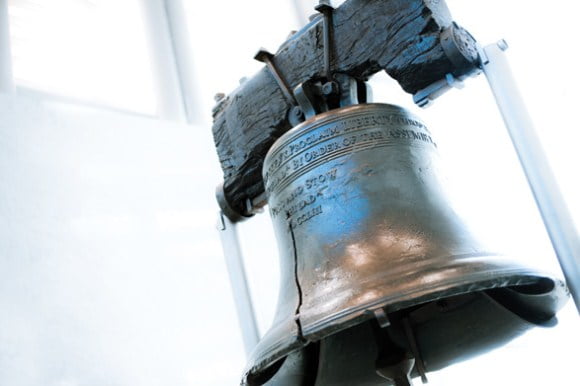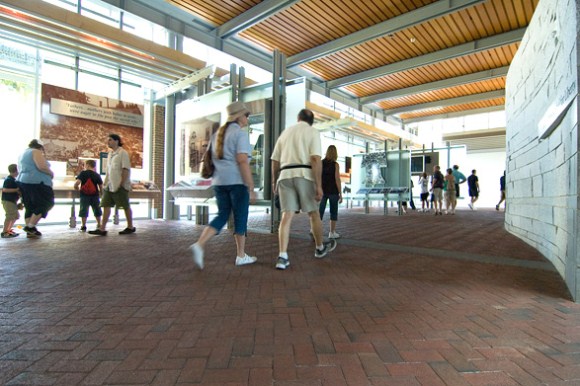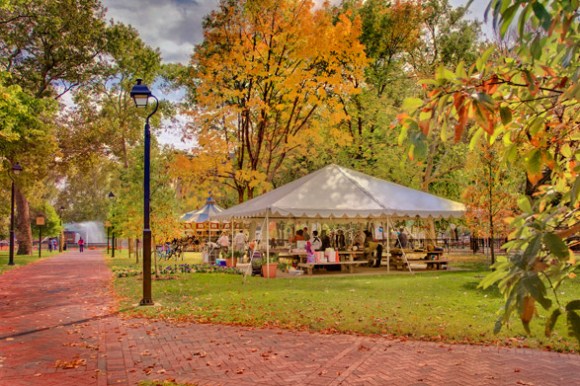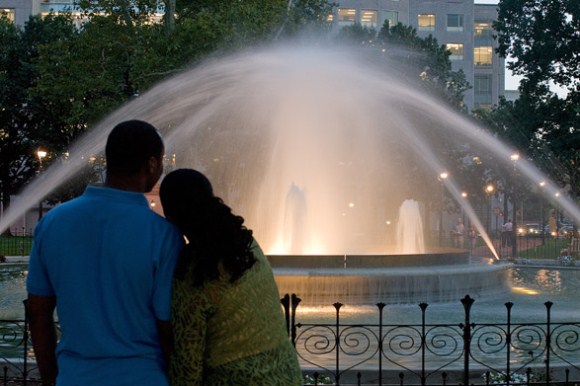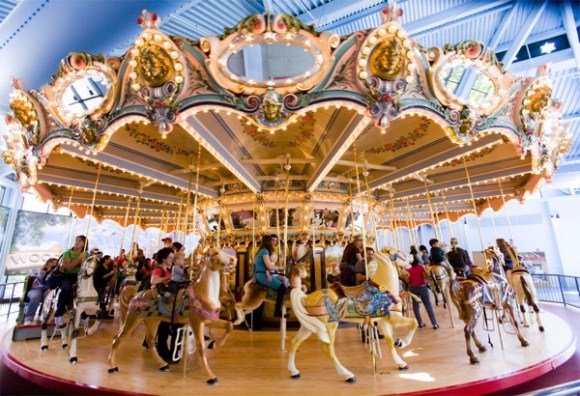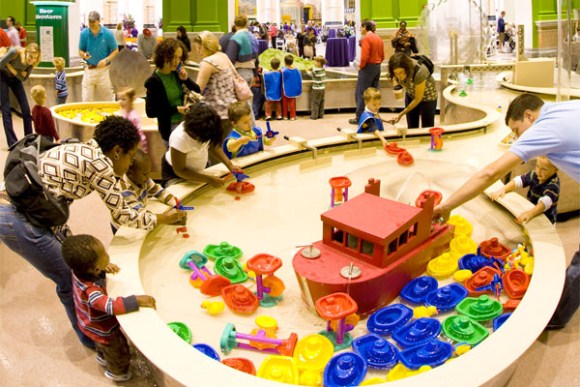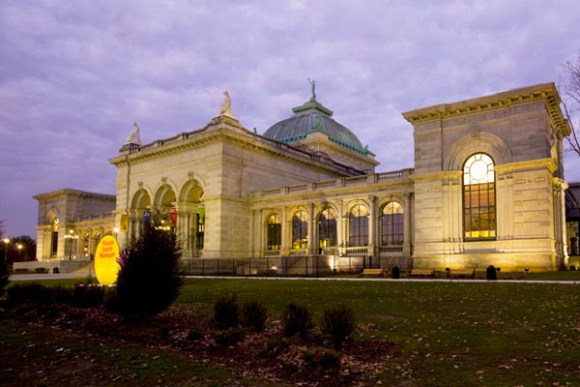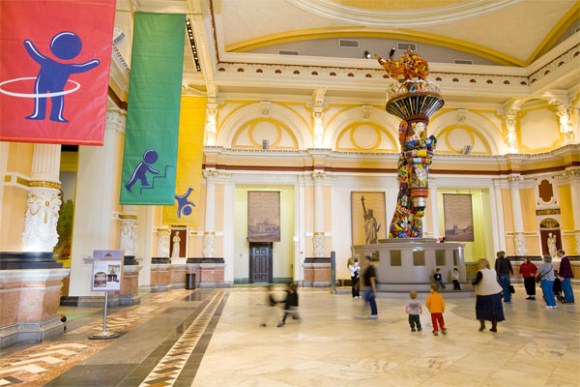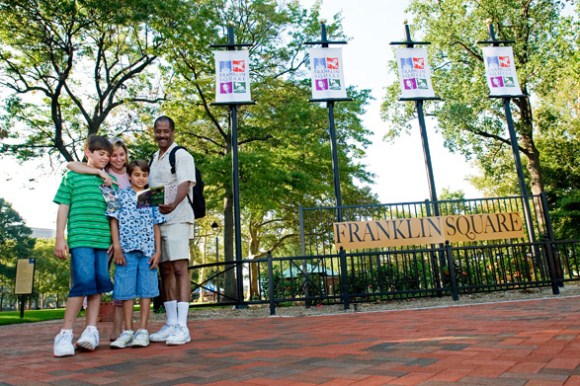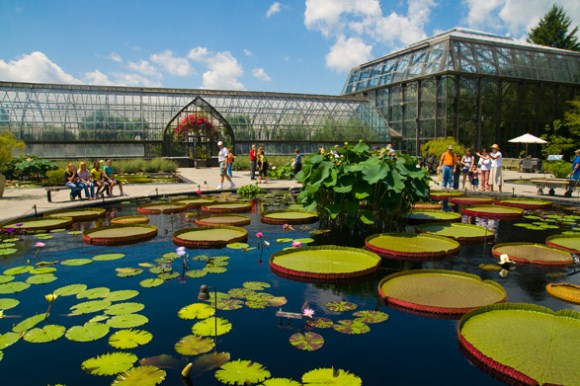Unlike the other squares, the early Southwest Square was never used as a burial ground, although it offered pasturage for local livestock and a convenient dumping spot for “night soil”.
History
By the late 1700s the square was surrounded by brickyards as the area´s clay terrain was better suited for kilns than crops. In 1825 the square was renamed in honor of Philadelphian David Rittenhouse, the brilliant astronomer, instrument maker and patriotic leader of the Revolutionary era.
A building boom began by the 1850s, and in the second half of the 19th century the Rittenhouse Square neighborhood became the most fashionable residential section of the city, the home of Philadelphia´s “Victorian aristocracy.” Some mansions from that period still survive on the streets facing the square, although most of the grand homes gave way to apartment buildings after 1913.
In 1816, local residents loaned funds to the city to buy a fence to enclose Rittenhouse Square. In the decade before the Civil War, the Square boasted not only trees and walkways, but also fountains donated by local benefactors – prematurely, it turned out, for the fountains created so much mud that City Council ordered them removed. The square´s present layout dates from 1913, when the newly formed Rittenhouse Square Improvement Association helped fund a redesign by Paul Philippe Cret, a French-born architect who contributed to the design of the Benjamin Franklin Parkway and the Rodin Museum. Although some changes have been made since then, the square still reflects Cret´s original plan.
Layout
The main walkways are diagonal, beginning at the corners and meeting at a central oval. The plaza, which contains a large planter bed and a reflecting pool, is surrounded by a balustrade and ringed by a circular walk. Classical urns, many bearing relief figures of ancient Greeks, rest on pedestals at the entrances and elsewhere throughout the square. Ornamental lampposts contribute to an air of old-fashioned gentility. A low fence surrounds the square, and balustrades adorn the corner entrances. Oaks, maples, locusts, plane trees, and others stand within and around the enclosure, and the flowerbeds and blooming shrubs add a splash of color in season.
Rittenhouse Square is the site of annual flower markets and outdoor art exhibitions. More than any of the other squares, it also functions as a neighborhood park. Office workers eat their lunches on the benches; parents bring children to play; and many people stroll through to admire the plants, sculptures, or the fat and saucy squirrels.
Public Art
Like Logan Square, you can see several of the city´s best-loved outdoor sculptures in Rittenhouse Square. The dramatic Lion Crushing a Serpent by the French Romantic sculptor Antoine-Louis Barye is in the central plaza. Originally created in 1832, the work is Barye´s allegory of the French Revolution of 1830, symbolizing the power of good (the lion) conquering evil (the serpent). This bronze cast was made about 1890.
At the other end of the central plaza, within the reflecting pool, is Paul Manship´s Duck Girl of 1911, a lyrical bronze of a young girl carrying a duck under one arm – an early work by the same sculptor who designed the Aero Memorial for Logan Square. A favorite of the children is Albert Laessle´s Billy, a two-foot-high bronze billy goat in a small plaza halfway down the southwest walk. Billy´s head, horns, and spine have been worn to a shiny gold color by countless small admirers.
In a similar plaza in the northeast walkway stands the Evelyn Taylor Price Memorial Sundial, a sculpture of two cheerful, naked children who hold aloft a sundial in the form of a giant sunflower head. Created by Philadelphia artist Beatrice Fenton, the sundial memorializes a woman who served as the president of the Rittenhouse Square Improvement Association and Rittenhouse Square Flower Association. In the flower bed between the sundial and the central plaza is Cornelia Van A. Chapin´s Giant Frog, a large and sleek granite amphibian. Continuing the animal theme, two small stone dogs, added in 1988, perch on the balustrades at the southwest corner entrance.
At Night
Once predominantly a daytime destination, Rittenhouse Square is now a popular nightspot as well, with a string of restaurants – including Rouge, Devon, Parc and Barclay Prime – that have sprouted up along the east side of the park on 18th Street.
So these days, you can take in the serenity of the natural landscape from a park bench in the sunshine and then sip cocktails under the stars at one of many candlelit outdoor tables.
Meanwhile, several more restaurants, bars and clubs have opened along the surrounding blocks in recent years, like Parc, Tria, Continental Midtown, Alfa, Walnut Room, and Twenty Manning just to name a few.
Frequently Asked Question
1. What is the address?
Rittenhouse Square is located at Tonnelle Avenue, New York City, NY 07047, United States
2. What is the contact number?
the phone number of Rittenhouse Square is (777) 666-6666. To learn more about Rittenhouse Square visit, http://www.fairmountpark.org/rittenhousesquare.asp.
3. What are the various mode of payment accepted here?
You can make payment Via Cash or Credit/Debit Card etc.
4. What is Rittenhouse Square known for?
the Rittenhouse Square is renowned as one of the top Attractions
